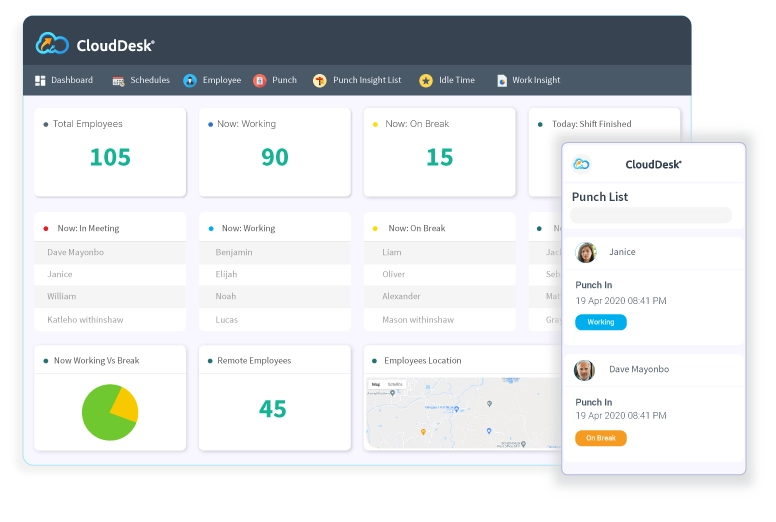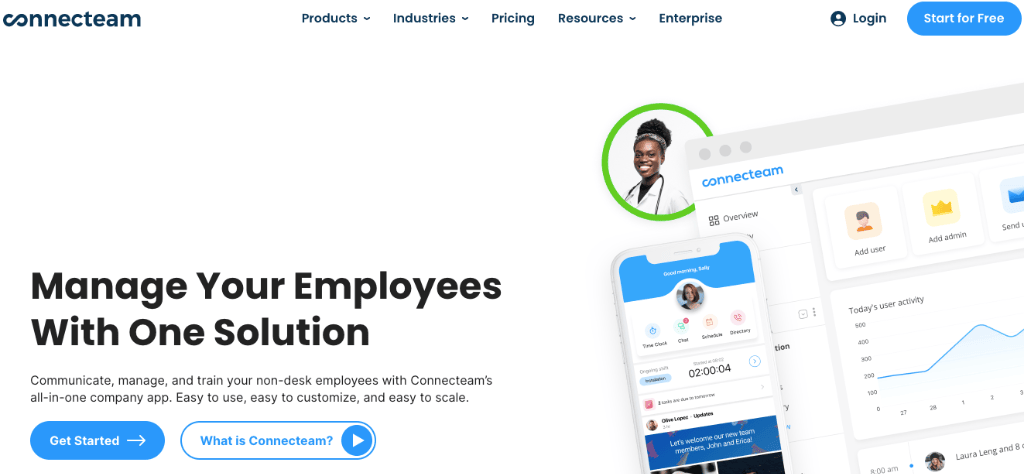Software used to monitor and track the actions of employees is called the software for monitoring employees. It lets employers collect information regarding employee behaviors like Internet use keys, app usages, keystrokes or even screen shots. Software for employee monitoring is mostly used to increase productivity, ensure compliance with corporate policies, protect sensitive data as well as address security issues. Several factors should be considered when choosing an employee-monitoring software. Here are some important points to consider: Features- Determine which features you need based on your organization's requirements. The features include monitoring email activities blocking websites and keystroke recordings, tracking application usage, and monitoring email. Prioritize features that are aligned with your goals for monitoring.
Compliance and Privacy- Check that the software is compliant with the ethical and legal guidelines for controlling employees. Familiarize yourself with applicable laws and regulations within your area, for example data protection and privacy laws. Search for software with transparency and adjustable privacy settings that respect employee rights.
User-Friendliness - Take into account the program's accessibility and user-friendliness. A user-friendly interface as well as a simple set-up process can save you time and make the process easier to implement. Consider a dashboard that is customizable and intuitive tools for reporting that let you easily navigate and interpret the data you have collected.
Integration and Compatibility: Verify the software's compatibility with your infrastructure. This includes operating systems, email software as well as project management platforms as well as collaboration tools. Monitoring that is compatible ensures smooth operation without disrupting your day-to-day activities.
Data Security: Examine the security measures implemented by the software to safeguard the data it collects. It is crucial to utilize encryption, secure storage of data and access controls. Make sure the software vendor is recognized for its data security track record and has strong security measures.
Scalability - Think about the software's capacity to grow in line with your business. Select a program that can easily scale up to meet the requirements of your business when you plan on adding more employees or new locations.
Analytics and Reporting - Examine the ability to report of the software. Take into consideration features that will give you a comprehensive view of employee performance, patterns and time allocation. Customizable analytics and reports help you identify improvement areas and make informed choices.
Customer Support - Examine the quality and accessibility of customer support offered by software companies. Find out how responsive, available as well as the quality of technical support they provide. Customer support is crucial to ensure quick resolution of issues.
Cost- Examine the pricing structure for the program. Is it a single payment, a monthly subscription, or based on usage? Know the pricing structure, including any additional charges for support, upgrades, or any additional features. Consider the cost and features of every product.
Transparency and communication with employees- Be transparent and communicate clearly with your employees when it comes to the deployment and use of monitoring software. Transparently describe the purpose the scope, goals, and the limitations of the monitoring. Be sure they are aware of their privacy rights and take care to address any concerns.
If you consider these elements, you can make an informed choice and select a monitoring system that meets your company's requirements while respecting the privacy of employees and the law. Follow the recommended employee monitoring company for site recommendations.

What Are The Distinct Features Of Employee Monitoring Software?
Software for monitoring employees includes a wide range of features to monitor and analyze employee actions. Different software applications may have various features, but these are the most common. It provides a detailed overview of how employees use their time.
Keystroke Logging- Keystroke logs record every keystroke made by employees. It can be used to assist in the identification of productivity bottlenecks, for identifying unauthorized activities and gathering evidence in the event of an investigation.
Screenshots and Screen RecordingScreen Recording and Screenshots - Certain software can capture screen shots of employees' computers regularly or record their screens in real-time. This can be useful in monitoring productivity or troubleshooting.
Internet Usage Tracking This feature monitors employees' online activities, including visited websites, search queries downloads, etc. This feature assists in identifying excessive non-workrelated browsing, possible security threats, and violation of policies.
This feature lets you track the applications that employees are using while working. It assists in identifying inappropriate and excessive use of apps by providing insight into the applications frequented.
Email Monitoring- Employers can monitor emails sent and received by employees as well as attachments as well as the content of the email. It aids in ensuring compliance with corporate policies, to prevent data leaks and also investigate any suspicious behavior.
Tracking of Documents and Files This feature monitors changes to files and their access. It helps safeguard sensitive data by monitoring collaboration between documents and ensuring compliance with data protection guidelines.
Remote Monitoring - Remote monitoring capabilities allow employers to monitor employees who work remotely or work from different locations. Employers can track their activity and ensure the efficiency of employees regardless of where they are.
Productivity Analysis. Monitoring programs for employees typically include features for productivity analysis that offer insight into employee working patterns and levels of productivity. These analyses help identify areas in need of improvement and can help to optimize workflow.
Reporting, Analytics and Visualizations- The powerful analytical and reporting tools create detailed reports and visualized data from the data collected. These reports give valuable insights regarding employee performance as well as the resource allocation.
Compliance and Policy Management - Software solutions can be adapted to ensure compliance with regulations, company policies and other industry standards. Employers can establish policies relating to acceptable use of computers as well as internet connection.
Alerts/Notifications: Alerts/notifications alert employers or managers whenever certain activities or events occur. They are able to warn you of suspect behavior, for example, excessive internet usage or attempts to access restricted websites.
These features are included in a variety of software solutions for employee monitoring. When choosing software make sure you select features that are compatible with your monitoring requirements and comply with your local ethical and legal guidelines. See the best time tracking monitoring software for blog info.

What Is The Best Software For Tracking Employees? Does It Comply With The Compliance And Privacy Law?
The software's capability to adhere to privacy and compliance regulations is vital. Software for monitoring employees must conform to certain privacy and compliance laws. While these may vary in accordance with the country of origin, some of them are generally accepted. The programs that monitor employees often have tools that allow employers to effectively communicate monitoring guidelines to employees. It could be necessary to provide written notices or obtain consent via consent forms. Or, an employee manual that outlines monitoring policies can be incorporated into the system.
Transparent Monitoring Policies: Employee monitoring software encourages transparency by ensuring employees know specific kinds of data that are collected, the purposes of monitoring, and the nature of monitoring. Clear and comprehensive policies aid employees in understanding the limits of monitoring as well as their rights regarding privacy.
Data Minimization Principles - Employee monitoring software frequently uses data minimization principles to comply with privacy legislation. Data minimization implies that only vital data is gathered, kept and not used. This software reduces the risk of privacy breaches by only collecting information that is required to monitor.
Some employee surveillance software can anonymize, or aggregate, information to ensure employees' privacy. Anonymization erases personally identifiable information (PII) from collected data and makes it difficult to associate data with specific individuals. Aggregation is the process of combining data from many employees to offer insights at a group level without singling out individuals.
Secure Data Store and encryption: Employee monitoring software puts the security collected data first. It employs secure data storage techniques and encryption to guard data from unauthorised access, breach, or even accidentally released data. This also includes safeguarding data on the move and at stationary.
Access Controls, Restricted Permissions In order to ensure compliance with regulations, employee monitoring software offers specific access rights and permissions. Employers are able to limit access to the monitoring data only to those who require it legally, such as HR employees or administrators.
Employee Rights and Remedies The protection of the rights of employees is essential in ensuring compliance with privacy laws and compliance regulations. Employee monitoring software often includes features that permit employees to access their personal monitoring data, request corrections or to make complaints. This lets employees act and exercise their rights when they feel their privacy has been infringed.
Compliance with Data Protection Regulations – Software for monitoring employees is designed to be compliant with applicable regulations. For example, the General Data Protection Regulations of the European Union and the California Consumer Privacy Acts of the United States. This includes implementing measures to safeguard personal data and respect the rights of the data subject.
It is important to note that while employee monitoring can help organizations comply with laws and regulations however, they must also consult lawyers and keep up-to-date with local laws and regulations. Compliance and privacy laws requires a comprehensive approach that goes beyond the software, and includes clearly defined policies, training for employees and monitoring for compliance on a regular basis. Follow the top employee monitoring company for website advice.
